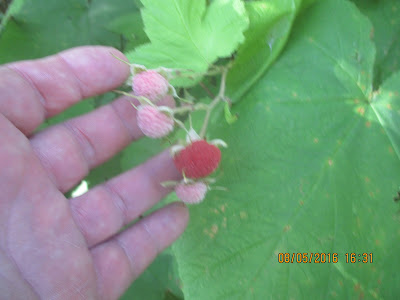 |
| LARGE, SWEET-SCENTED WHITE FLOWERS... |
 |
LARGE, MAPLE-LIKE LEAVES...
|
 |
| PINKISH UNRIPE BERRIES... |
 |
| ...RED WHEN RIPE... |
 |
| ...THE "THIMBLE BERRY" |
Tuesday, 8:30 AM. 70 degrees F at the ferry dock, 65 on the back porch. Wind WSW, calm with light gusts. The sky is clear with some haze. The humidity 84%, and the barometer has bottomed out, at 29.84", predicting the chance of thunderstorms Wednesday and Thursday. It will be a warm and humid summer day.
Daughter Greta leaves to return to Columbus, Ohio this morning. We have had a good visit with our oldest child and her two dogs; the black lab pup is adorable but has probably worn out his welcome for a while, at least. We wish them all a safe and pleasant trip home.
Thimbleberries , Rubus parviflorus, in the Rose Family (Rosaceae) are getting ripe now, seemingly one at a time. They are at first almost white, then turn pinkish and finally red. They have a pleasant but rather bland flavor, and when dead ripe can be easily pulled from the stalk, the ripe berry being hollow, looking like a sewing thimble, thus the common name. The berries are almost round, nearly globe-like. The plants, which can be very large, are unarmed, without thorns or prickles, and the leaves large and maple-like.
The thimbleberry flowers, described in an earlier post, are large, white, sweet scented and rather few. The native range of the thimbleberry is northeastern Canada and the northeastern US, and around the Great Lakes. This is a good plant for naturalizing in the northern half of the State of Wisconsin.
















No comments:
Post a Comment